Please Note- this website is best viewed on a desktop/laptop as it is not mobile-friendly. I am working on trying to convert it!
Joseph Austin Benwell was a prolific illustrator for various Victorian religious publications, particularly those published by the Religious Tract Society. The nineteenth century was a time when missionaries travelled to all corners of the world, to spread the word of the Gospel and to try and convert so-called ‘heathen’ peoples to Christianity, whether they liked it or not. It was also a time when there was Christian concern that there should be 'appropriate' reading material provided for people at home in Britain.
The era therefore saw publication of a variety of religious journals and magazines, many aimed at the general public and some targeting younger readers. With their paternalistic, benevolent and somewhat evangelical missionary quality, these publications can seem rather quaint and 'politically incorrect' when viewed through modern eyes. Such publications and the illustrations they contained are, however, of social and historical importance, as they recorded how many people thought, felt and behaved at the time. Joseph Austin Benwell, an artist who had lived in 'foreign lands' and specialised in pictures of local Eastern scenes, customs and practices, also of missionaries, was well placed to provide illustrations for such publications. He also illustrated and painted scenes from the Holy Land, mainly of Jerusalem, Palestine and Sinai.
The Religious Tract Society, founded in 1799, was one of the leading publishers of evangelical tracts and periodicals in the nineteenth century. Many of these volumes have been digitised and can be viewed online via institutions such as the Hathi Trust Digital Library. Some of the Religious Tract Society publications that Benwell provided illustrations for were:
‘The Leisure Hour, A Family Journal of Instruction and Recreation’. The Leisure Hour was a very successful family weekly, published at a cost of one penny for many years from the 1850s. The journal was not as overtly religious in its content as other Religious Tract Society publications, and was printed without the RTS imprint. It was targeted at a very broad range of readership. As well as the Indian Nabob series in the 1858 volume (refer British in India), Joseph Austin Benwell illustrated a series in the 1857 volume entitled ‘Tales Illustrative of Chinese Life and Manners’.
‘The Sunday at Home’: A Family Magazine for Sabbath Reading’. Founded in 1854, this periodical flourished until the early twentieth century. Joseph Austin Benwell provided illustrations for several years from 1856 to 1870 for regular articles and series such as 'Missionary Perils' (1857); 'Nurse Grand In India' (1857); ‘The Apostle to the Maoris’(1857); ‘Light from the East’ (1857, 1858, 1859); ‘Systems and Superstitions of the Chinese’ (1858); ‘The Martyr Church of Madagascar’ (1859); 'True Story of an Irish Boy' (1859); ‘Notes of a Medical Missionary (to the Jews)’ (1861); ‘Leaves from my Portfolio by a Missionary in Bengal' (1862); ‘Indian Experiences in 1857-58’ (Indian Mutiny 1857-58) (1862); ‘The Fountain Kloof: or, Missionary Life in South Africa’ (1863).
He illustrated a series called ‘Life of Swartz’ (1860), about the life of Christian Frederick Swartz (or Schwarz) (1726-1798), the German Lutheran Protestant who was a missionary in India in the mid to late eighteenth century. In the 1861 ‘Sunday at Home’ he did some engravings for another series- ‘David Brainerd- Missionary to the Indians’. Brainerd (1718-1747) was an American missionary to native Indians, particularly the Delaware Indians of New Jersey. Other missionary series that he illustrated were ‘Dr. Krapf’s Missionary travels in Eastern Africa’, about German Lutheran Johann Ludwig Krapf (1810-1881) and ‘The Gospel on the banks of the Niger’, both published in 1861. Krapf was exploring and working in Ethiopia (then Abyssinia) at about the same time that the more well-known Dr Livingstone was travelling in southern Africa and Mozambique, and they appeared to have come within about five degrees of each other.
Benwell also illustrated ‘The Apostle of the Maoris’, a short series published in The Sunday at Home in 1857 about Samuel Marsden (1764-1838). Samuel Marsden was described as the first apostle to the Maori race, and is said to have introduced Christianity to New Zealand.
As well as missionary topics he illustrated series with a Biblical theme, for example ‘Studies from the Life of David’ (1860), ‘Ruth’ (1860) and ‘Rainless and Dewless Years' (1860), including scenes from ancient Samaria and the life of Elijah.
The 1862 edition of 'Sunday at Home' refers to '...an interesting series of 'Indian Illustrations of Scripture', delivered in the form of a lecture by the Rev W M Robertson BA of London, with the aid of 'dissolving views' painted by Mr Benwell, formerly of Calcutta, many of whose Indian scenes have already appeared in The Sunday at Home’.
The Picture Scrap Book series published by the Religious Tract Society were aimed at children, and comprised four volumes. They contain illustrations by Benwell, among others. In particular two of the volumes, ‘The Picture Scrap Book; or Happy Hours at Home‘ (Scripture Scenes etc.) (1859), and ‘The Picture Scrap Book (Bible Pictures &C’ (1864) are fully illustrated with scenes of the Holy Land and the East (including sections on ‘Light from the East’ and ‘Scenes in Foreign Lands). Many of these illustrations are by Benwell.
It is worth expanding a little on the Picture Scrap Book series as some sources give varying and, I believe, incorrect dates. For example, the University of Florida (George A Smathers Libraries) give dates of 1855 and 1883 for the first series editions of ‘The Picture Scrap Book; Happy Hours at Home’ (Part 1 Scripture Scenes), but this is not possible, as we will see. The date of 1850 given for the book in the second "new series" (Bible Pictures &c) cannot be correct either. I contacted them twice several years ago, as the website invited individuals to comment, but had no reply. WorldCat.org gives the dates of 1859, 185_ or 1883 for the first series and 1864 for the second "new series". Princeton University has a date of 1859? for the first book, which I believe to be correct. My research has led to the following conclusions:
A, The Picture Scrap Book; Happy Hours at Home – is in two parts 1) Bible Scenes/Scripture Prints etc (pp1-64), and 2) Home Pictures (or Home and Country Pictures (pp71-136). This was the first 'Picture Scrap Book' to be published. It contains a lot of illustrations previously printed in the periodical 'Sunday at Home - A Family magazine. for Sabbath Reading' during 1857 and 1858 (available online at HathiTrust.org). . For example, the sections 'Light From the East' and 'Pictures of Foreign Lands' contain a lot of engravings by Benwell that had already appeared in 'Sunday at Home' in 1857 and 1858. Based on the dates the engravings first appeared, I do not think the publication date of 'Happy Hours' can be 1855. but is 1859. Similarly:
B. The Picture Scrap Book- New Series- is in two parts 1) The Seasons and Home Traveller (pp1-68), and 2) Scripture Prints and Bible Lands (pp69-136). This volume also contains many illustrations taken from 'The Sunday at Home' between 1859 and 1863. I have focused in particular on the sections 'Scripture Illustrations' and 'The Foreign Traveller', as eastern/Indian scenes were one of Benwell's specialities. To give just one of many examples, the illustration 'A Hindoo Workman worshipping his Tools' in the Picture Scrap Book New Series (p101) also appears in the 'Sunday at Home 1862' as 'Indian Poojah to Tools'. How could the second "new series" have a date of 1850, if it contains engravings that were first published elsewhere between 1859 and 1863? And why would the first series be dated later? I believe the correct date is 1864.
This was the first time these illustrations had been seen, and I am certain they did not exist in 1850. Also, the style of the illustrations are Benwell's later, more distinctive style (late 1850s-early 1860s), compared to his very early engravings from 1850-55. 1850 was too early. To summarise, it seems that The Religious Tract Society decided to compile a picture book for children based on existing suitable illustrations taken from the 'Sunday at Home' journals 1857-58 (also published by RTS) in 1859. Then five years later they decided to publish a second 'new' series in 1864, based on existing 1859-1863 illustrations that had subsequently appeared in 'Sunday at Home'.
Another Religious Tract Society book illustrated by Benwell was ‘A Home in the Land of Snows and other Sketches of Missionary Life’ (Romance of Modern Missions), 1870 by Miss Cecilia Lucy Brightwell. He illustrated 'Nurse Grand in India' from 'Nurse Grand's Reminiscences at Home and Abroad' , 1871, also by Cecilia Lucy Brightwell. He also provided illustrations for ‘Narratives for Youth, Volume 2’ published by the English Monthly Tract Society in the early 1860s. He did the title page (see below), showing Leominster Church and Vicarage, for the book ‘The Folded Lamb; Memorials of an Infant Son’ (1857 edition) by Mrs Ellen M Rogers, wife of Rev. George Albert Rogers, published by Wertheim & Macintosh. He also provided several illustrations for ‘The Picture Gallery of the Nations’ 187[0].
Benwell also provided illustrations for other Victorian periodicals, although not necessarily with a religious theme, including: ‘The Cornhill Magazine’ Vol 1 and Vol 2 1860, Publisher: Smith, Elder and Co, 65 Cornhill, London, and ‘The Welcome Guest: a Magazine of Recreative Reading for All’ 1858-1861, Publisher: Houlston and Wright, London. The Cornhill Magazine, a literary journal founded in 1860 and published until 1975, featured stories and articles by many famous and distinguished Victorian writers.
For more pictures of India, please also refer to the page 'Scenes from India'.
Some examples of Joseph Austin Benwell's work for Victorian religious publications are shown below.
Joseph Austin Benwell's art - Orientalist Paintings
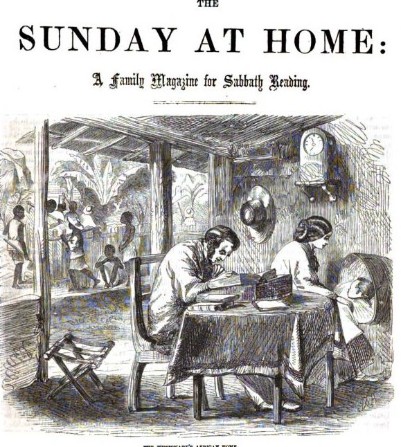
'The Missionary's African Home' Sunday at Home 1859
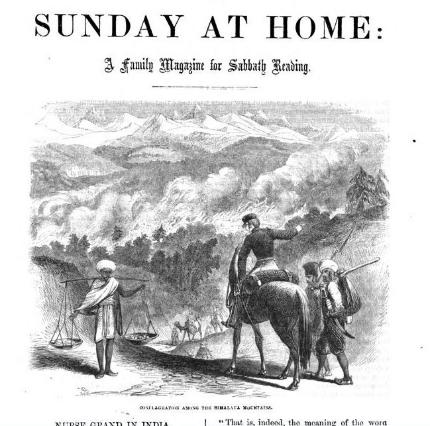
'Conflagration among the Himalaya Mountains' Sunday at Home 1857
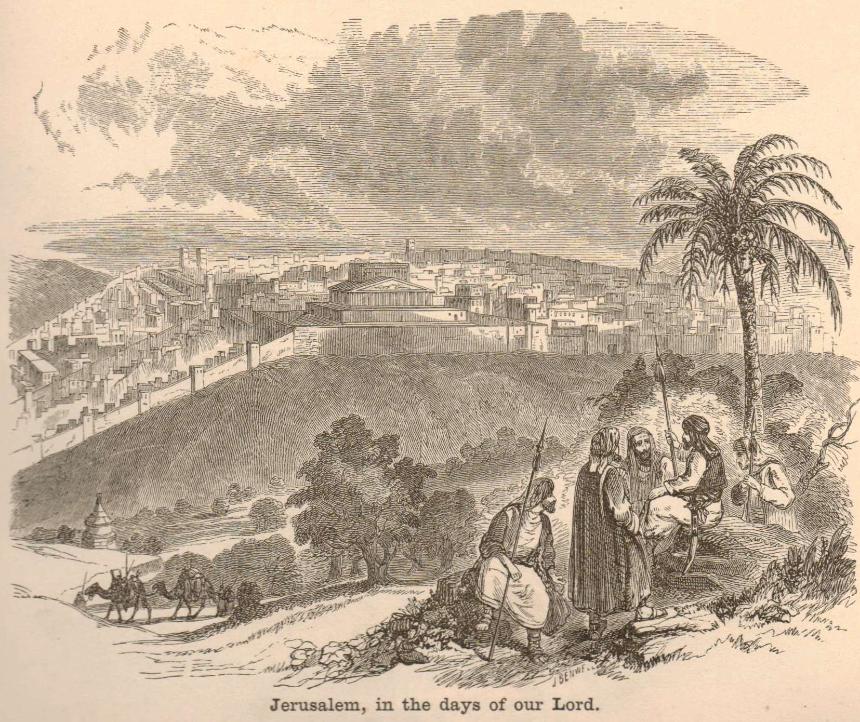
'Jerusalem, in the days of our Lord' from ' ‘The Picture Scrap Book, or Happy Hours at Home', 1859 (Bible Lands) p 37

'Hindu Village Council' from 'Indian Gems for the Master's Crown' by Miss Droes of Landour, India, 1892.
The same illustration as ‘The Headman of a Hindoo Village holding his court’, ‘Nurse Grand in India’ Chapter 4, Sunday at Home 1857
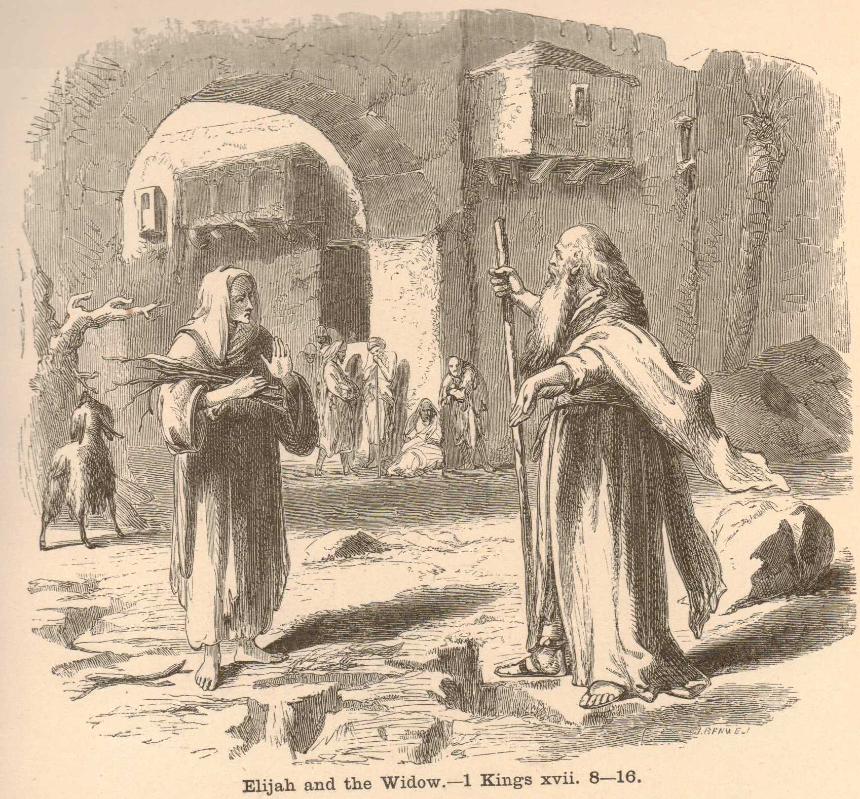
'Elijah and the Widow' from ' ‘The Picture Scrap Book, or Happy Hours at Home', 1859 (Old Testament Scenes) p 17
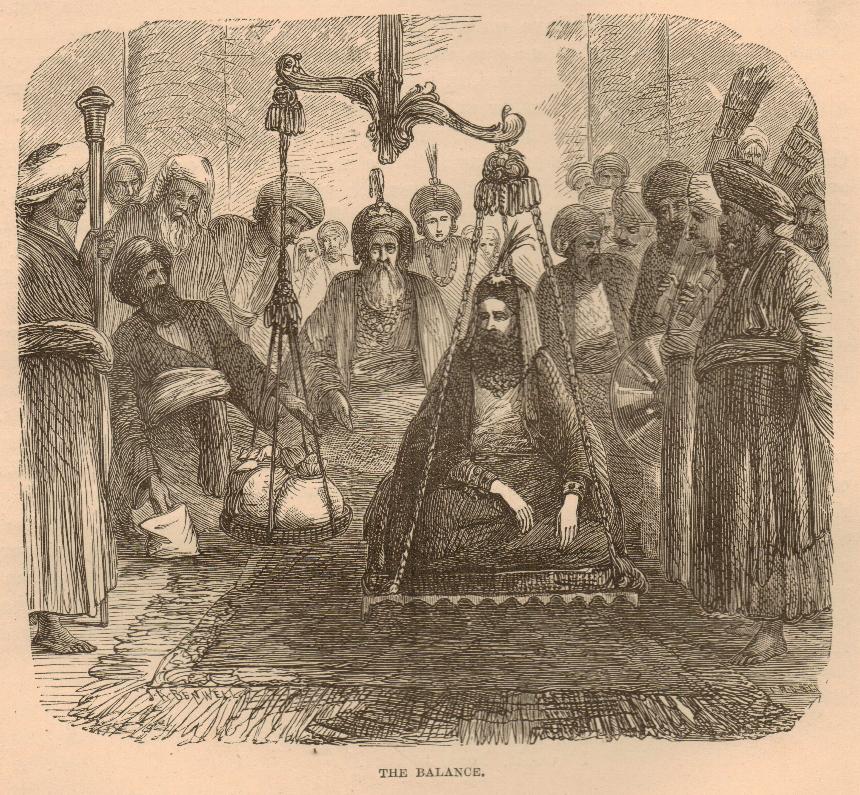
'The Balance' or 'Weighing the Raja of Travancore' from 'Rays from the East' (1871) and 'True Tales about India' (1876) and both published by The Religious Tract Society. This engraving also appears in 'The Sunday at Home' 1860, as 'Scene described by Sir Thomas Roe in his voyage to India'.
"...whenever a new Raja began to reign, he was expected to have himself weighed. and to give the weight in gold away among the Brahmins who came to assist at the ceremony." (True Tales about India).
Another description (from Rays from the East)- "...there is a curious illustration in the account of Sir Thomas Roe's voyage to India, about the year 1660. 'The first of September (which was the late Mogul's birthday), he, retaining an ancient yearly custom, was weighed in the presence of his chief grandees in a balance. The ceremony was performed within his house, or tent, in a fair spacious room, whereunto none were admitted but by special leave. The scales in which he was thus weighed were plated with gold, an so the beam, on which they hung with great chains, was made likewise of that most precious metal. The King, sitting in one of them, was weighed first against silver coin, which immediately after was distributed among the poor: then he was weighed against gold: after that against jewels (as they say); but I observed (being there present with my lord ambassador) that he was weighed against three several things, laid in silken bags on the contrary scale. When I saw him in the balance, I thought on Belshazzar, who was found too light."
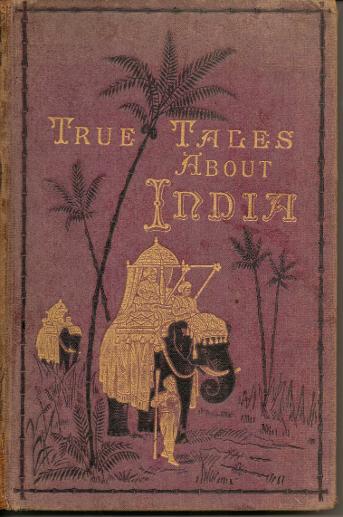
'Cover of True Tales about India' by S J Ballard of Mangalore (1876) published by the Religious Tract Society

Cover of 'The Children of India ' by one of their friends [Annie Westland Marston] (1883), published by the Religious Tract Society
''Hindu Children' from The Children of India by Annie Westland Marston, 1883
Also appeared as ‘Hindoo Nursing Women’ in ‘Light from the East’ The Hindoo Mode of carrying Infants in Sunday at Home, 1858
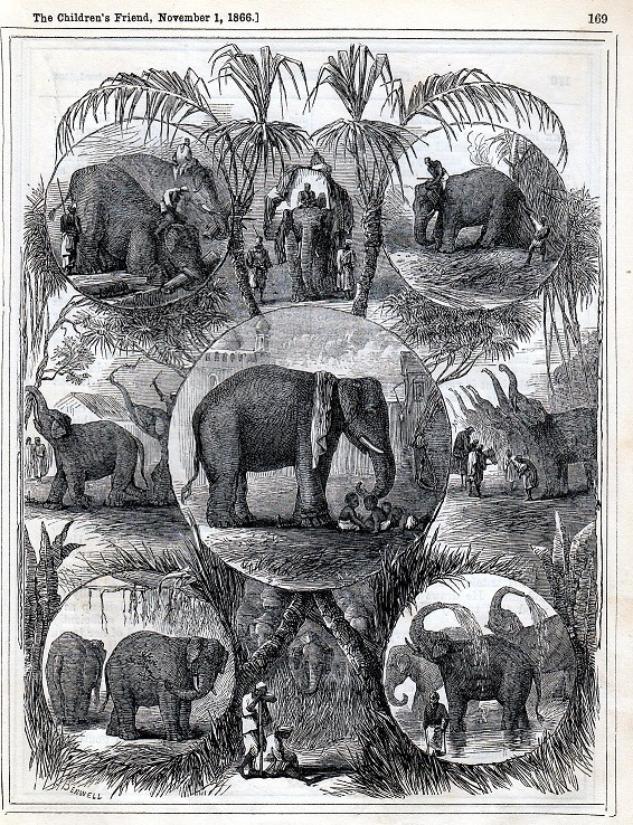
'The Elephant' from The Children's Friend' November 1, 1866.published by Seeley & Co, Fleet Street, London
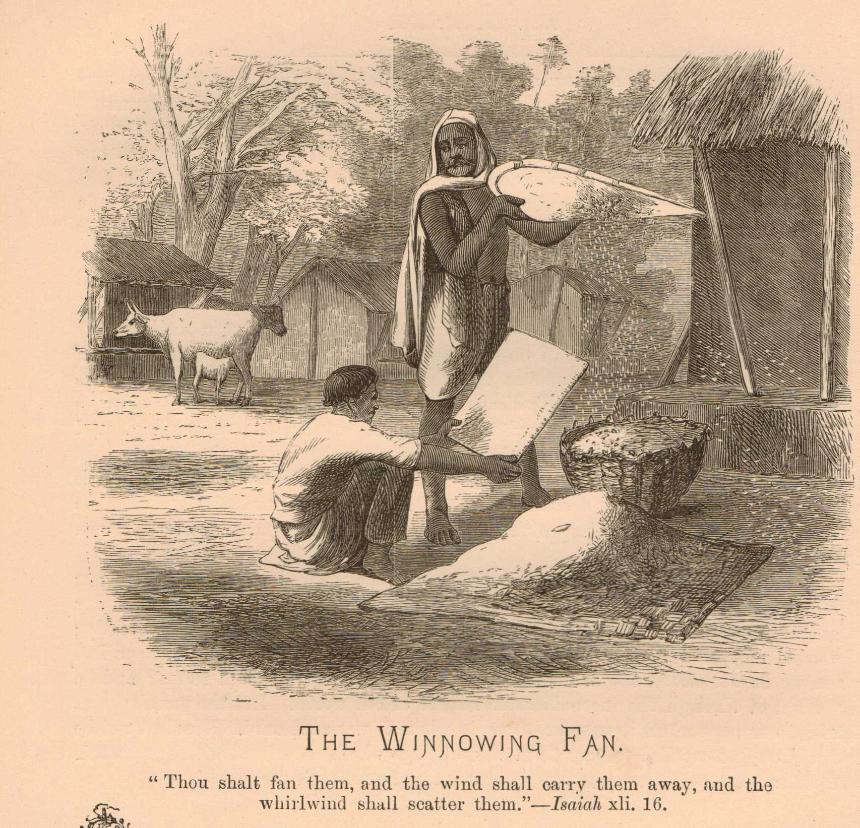
The Winnowing Fan' from 'Rays from the East' (1871), published by The Religious Tract Society
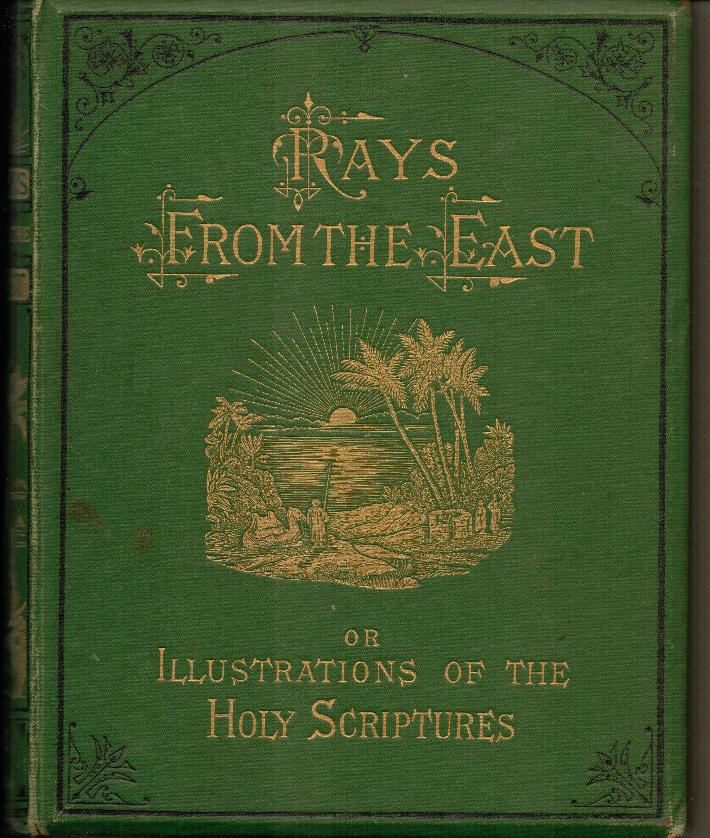
Cover of 'Rays from the East' (1871), published by The Religious Tract Society
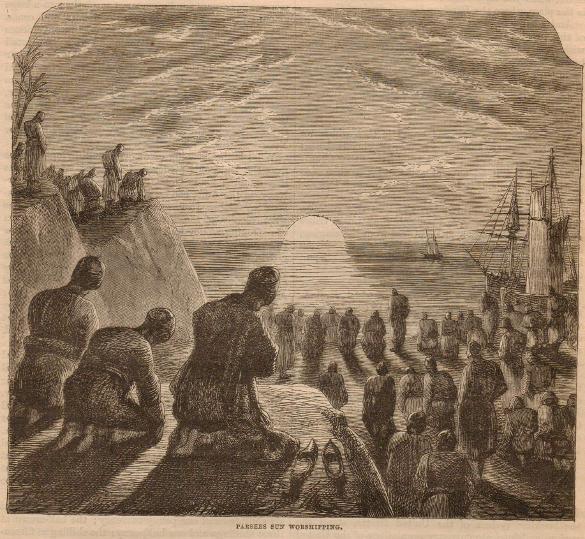
'Parsees Sun Worshipping' from 'Letters from Bombay', The Leisure Hour 10 December 1864

Parsees worshipping the setting sun' from 'The S.P.G. Picture Book, showing origin, and scenes in the work of the Society for the Propagation of the Gospel in Foreign Parts' 1896.
'This engraving was originally published in the Illustrated London News on 31 October 1863 as 'Guebers of India worshipping the setting sun', but the artist's signature was left off this later version. Parsees and Guebers are descendants of ancient Persians who follow the Zoroastrian religion, many of whom fled to escape religious persecution. The subject is similar to the 1864 Leisure Hour engraving, also shown above.
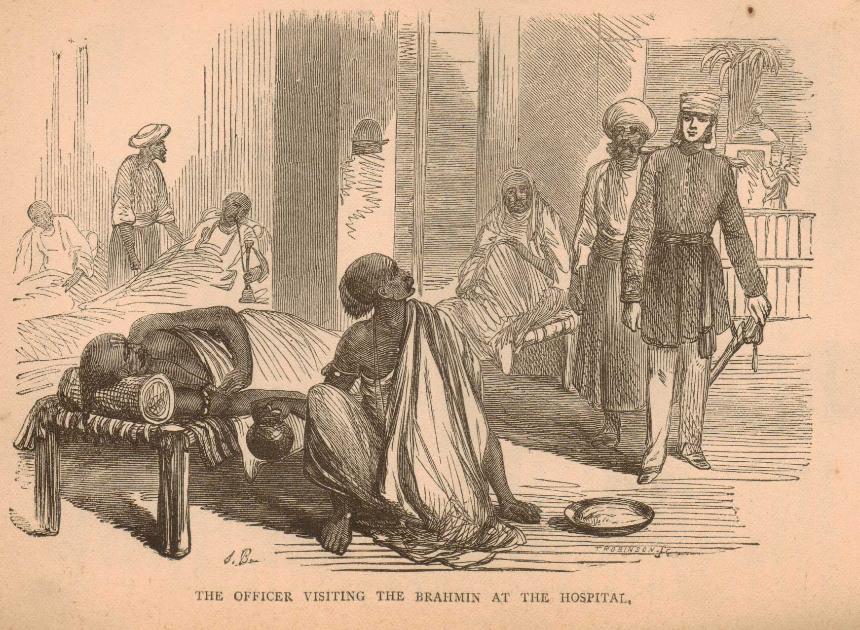
The Officer visiting the Brahmin at the hospital' from Sunday at Home, 1857, serial 'Nurse Grand in India'.

'An Inattentive Congregation', David Brainerd- Missionary to the Indians (Chapter 2), Sunday at Home 1861
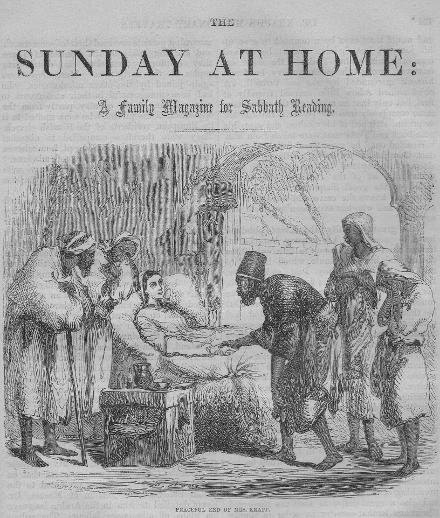
'Peaceful end of Mrs Krapf', Dr. Krapf’s Missionary travels in Eastern Africa (Chapter 2), Sunday at Home 1861
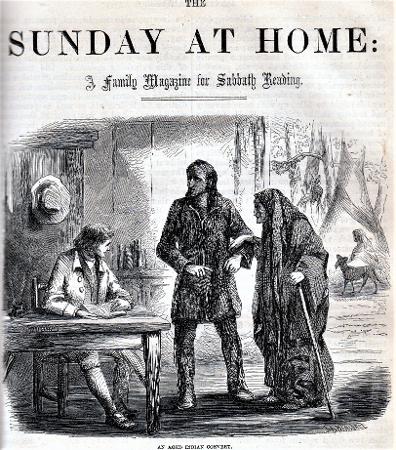
An aged Indian convert' David Brainerd, Missionary to the Indians (Chapter 4), Sunday at Home 1861
The native Missionary's departure from Onitsha' ,The Gospel on the banks of the Niger (Chapter 4), Sunday at Home 1861
'
"Everything was going well in our market at the camp", Mr Crowther writes......."till this morning a slave trader took it in his head to bring a little girl about six years of age for sale. What a contrast there was between the cheerful countenances of the children who accompanied their mothers, assisting to carry their yams and rice to market, and the dejected spirits of this unfortunate slave-child, under the hand of an unfeeling slave-trader. As soon as the news of the fact had reached Dr Baikie, he marched the slave-trader out of the camp with his merchandise in the sight of innocent traders with no ordinary effect. They have heard that the English are averse to the slave-trade; now they have opportunity of proving it to demonstration."
The article in Sunday at Home is based on the British Niger expedition of 1857. Samuel Ajayii Crowther (c1809-1891), born in what is now western Nigeria, was a missionary and the first Anglican Bishop in Nigeria. As a child, he had been captured by Fulani slave raiders in 1821, and was rescued by a British Royal Navy ship; he later converted to Christianity. William Balfour Baikie (1825-1864) was a Scottish explorer, naturalist and philologist. He had the role of British Consul in 1857, and later translated the Psalms into Hausa.
'The Slave Dealer ordered out of the camp' The Gospel on the banks of the Niger (Chapter 2),Sunday at Home 1861
'The Slave Dealer ordered out of the camp' The Gospel on the banks of the Niger (Chapter 2),Sunday at Home 1861
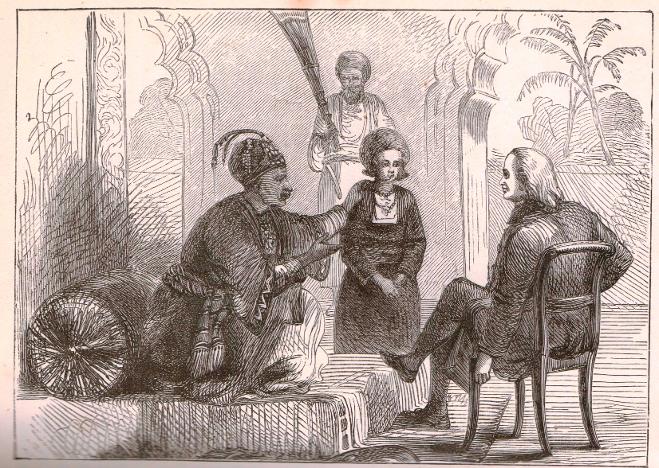
'Serfojee commended to Schwatrz' from 'The Vanguard of the Christian Army' [or, 'Sketches of Missionary Life'] published by the Religious Tract Society, 1882.
'
This illustration also appears as ‘The Rajah’s adopted son, Serfojee, introduced to Mr Swartz’, ‘Life of Swartz’ in ‘The Sunday at Home' 1860. The original is signed J A BENWELL DEL lower left, but in the later version the lower part of the engraving is cut off.
Del usually indicates the name of the artist, as opposed to the engraver. Del.: delineavit – Latin for he/she/they drew. The name precedes it, usually found on the bottom left side of the plate.
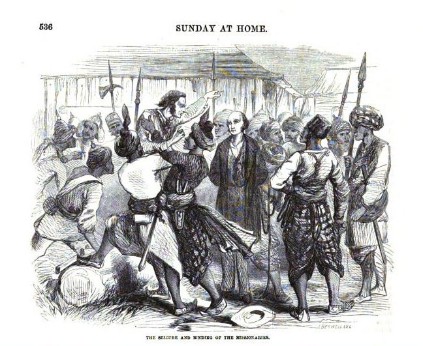
'The Seizure and Binding of the Missionaries' Sunday at Home 1857
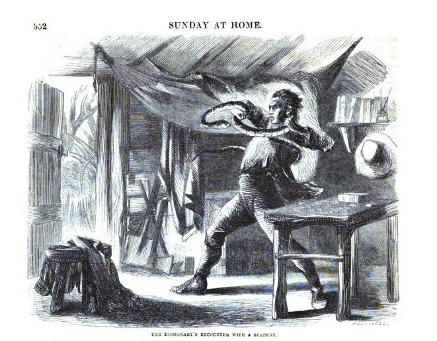
'The Missionary's Encounter with a Serpent' Sunday at Home 1857
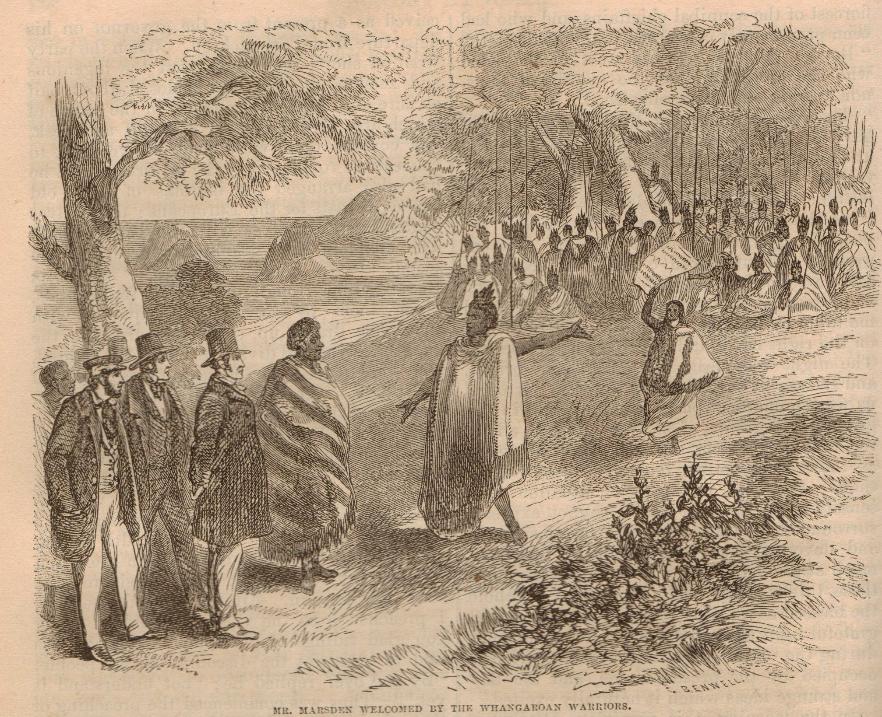
'Mr Marsden welcomed by the Whangaroan Warriors' from 'The Apostle of the Maoris', Sunday at Home 1857
'
The scene illustrated above took place at the Bay of Islands in December 1814, just prior to Marsden conducting the first Christian service on New Zealand soil during Christmas Day 1814. "It is interesting to know that one of the first acts of Mr Marsden was to negotiate peace between the nations of the Bay of Islands and the Whangaroan tribes.......... On reaching the shore, Ruatara boldly went forth to the hostile camp, and after explaining that some white men desired a friendly conference with them, retreated to his own party. An interval of almost breathless suspense succeeded. What was the result to be- peace or war- reconciliation or a deadlier feud? We can well imagine the fervent breathing that in those anxious moments ascended from the trembling hearts of those devoted men. Shortly, a woman was seen advancing from the Whangaroan crowd of warriors, flourishing a red mat round her head, and crying out "Haromai, Haromai," (Come hither, come hither). This was said to be the symbol of pacific intentions, and the visitors approached. ....... The warriors, seizing their spears, brandished them, as if in fury, against one another; yells, shrieks and roars vexed the air; while the frightful gesticulations and horrible contortions of face and limb were suggestive of the writhing of fiends. Yet this terrifying demonstration was their war-dance of welcome! Conversation ensued......"
Samuel Marsden (1765-1838) was an English-born Anglican cleric and a prominent member of the Church Missionary Society, believed to have introduced Christianity to New Zealand.
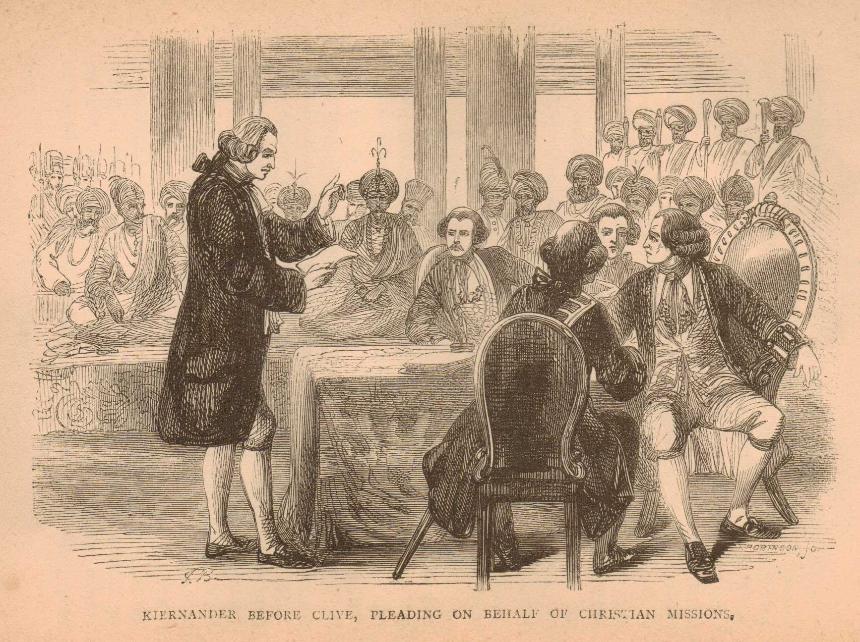
'Kiernander before Clive, pleading on behalf of Christian Missions' Sunday at Home 1857 (Nurse Grand in India). This illustration also appeared in 'Nurse Grand's Reminiscences at Home and Abroad' by Miss Brightwell, 1871.
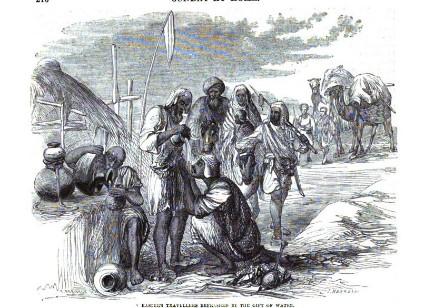
'Eastern Travellers refreshed by the Gift of Water' Sunday at Home 1857

'Eastern Women Grinding Corn' Sunday at Home 1857

From the front cover of 'Hindoo Life' by Rev Edward Webb, 1866.
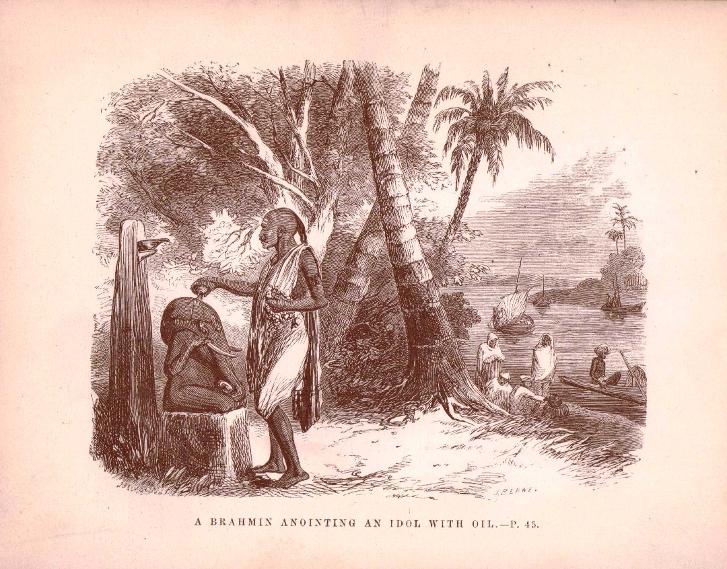
'A Brahmin anointing an idol with oil' from Hindoo Life by Rev Edward Webb, 1866
A Brahmin offering oil to an idol' from Sunday at Home 1858

'Pouring oil on the head of Ganesa' from The Oriental Picture Gallery edited by the Rev John Liggins, 1866
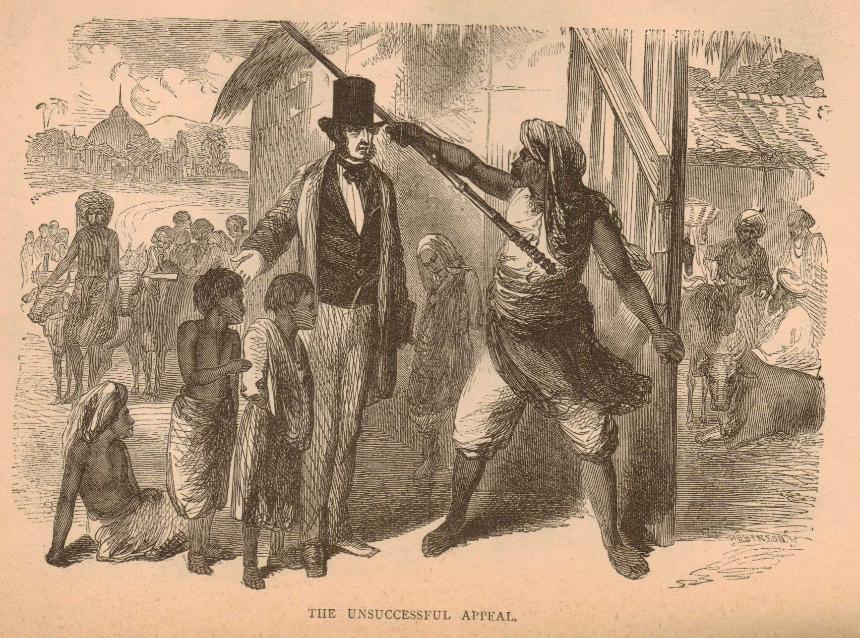
'The Unsuccessful Appeal' Sunday at Home 1857 (Nurse Grand in India - Schools, their trials and joys)
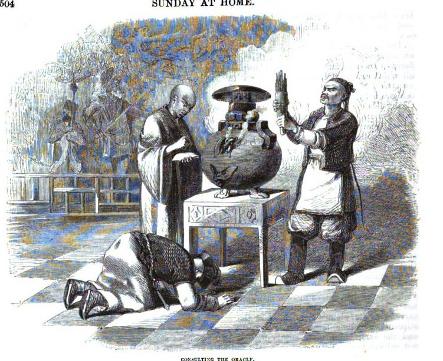
'Consulting the Oracle' Sunday at Home 1858
Also appears in 'The Oriental Picture Gallery' ed Rev John Liggins, publ. Hurd and Houghton, New York, 1866
''Hindu Wedding - A Midnight Procession' from The Children of India by Annie Westland Marston, 1883
Also appeared as ‘A Midnight Wedding in India’, ‘Light from the East’ from Sunday at Home 1858, and in 'The Picture Scrap-Book' 1859, published by the Religious Tract Society
'Display of the Bridal gifts' The Leisure Hour 12 February 1857
from 'Wedding Gifts, an Oriental Sketch', set in Latakia, Syria
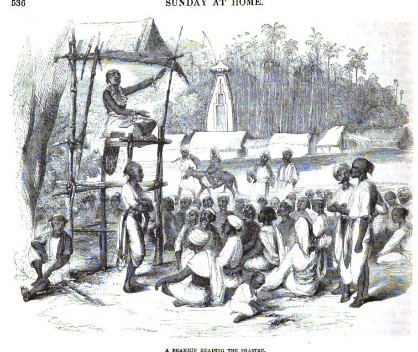
'A Brahmin reading the Shastre' Sunday at Home 1858
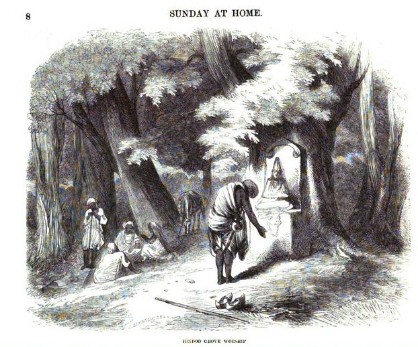
'Hindoo Grove Worship' Sunday at Home 1858
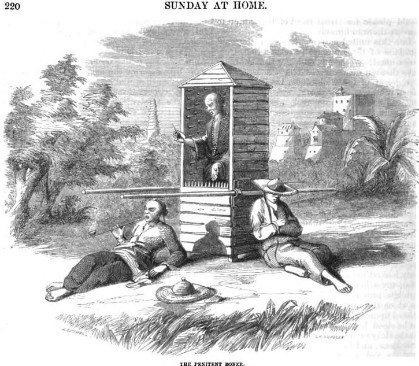
'The Penitent Bonze' Sunday at Home 1858
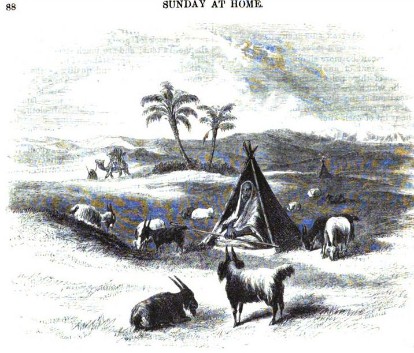
'An Eastern Shepherd's Tent' Sunday at Home 1858

'A puzzler for the Mohammedan doctor' Sunday at Home 1862 (Leaves from my portfolio' by a missionary in Bengal.)
Discussing the Injeel (Gospel) and the Koran.

'An Eastern Bed' Sunday at Home 1859
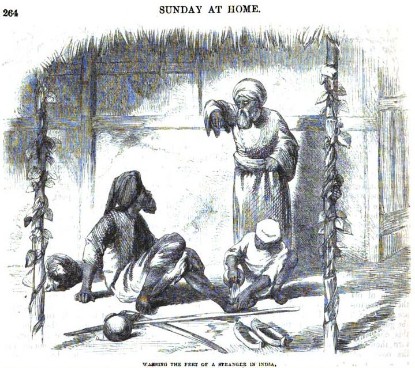
'Washing the feet of a Stranger in India' Sunday at Home 1859
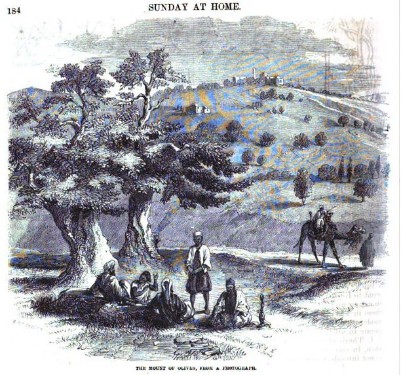
'The Mount of Olives, from a photograph' Sunday at Home 1859
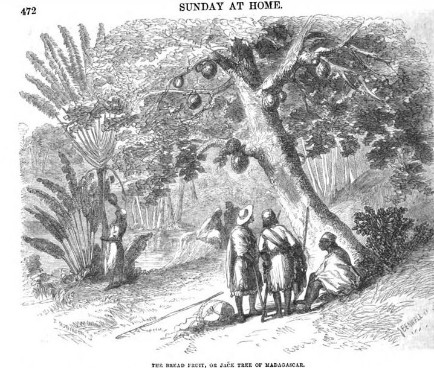
'The Bread Fruit or Jack Tree of Madagascar' Sunday at Home 1859
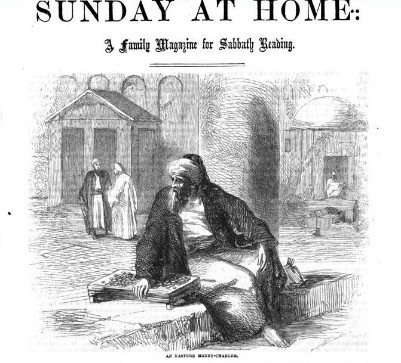
'The Oriental Money-Changer' Sunday at Home 1860
'"Our engraving represents a money-changer sitting on the steps leading to the court of the mosque of Omar, just as in the gospel history the Jews were wont to sit precincts of that very enclosure."
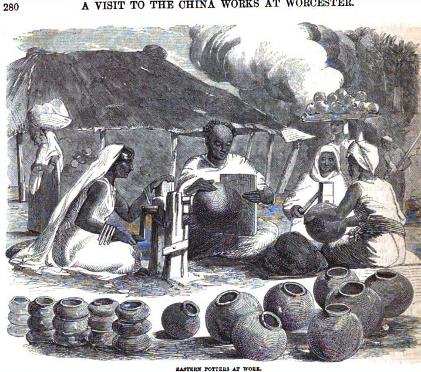
'Eastern Potters at Work' Sunday at Home 1860
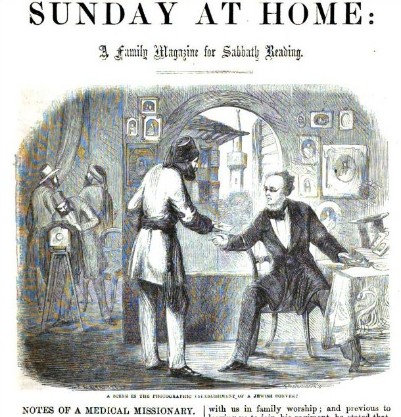
'A Scene in the Photographic Establishment of a Jewish Convert', Notes of a Medical Missionary; Sunday at Home 1861
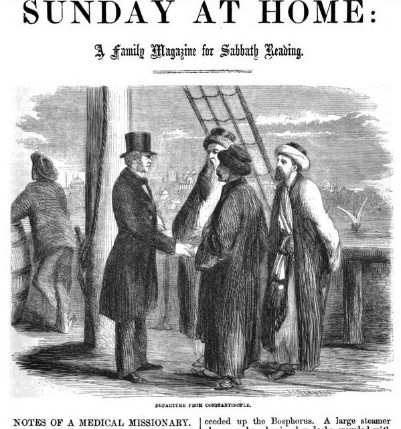
'Departure from Constantinople', Notes of a Medical Missionary; Sunday at Home 1861
'Notes of a Medical Missionary' was the main feature article in nine consecutive issues of the 'Sunday at Home' published between June and August 1861. The narrative was by John Mason, the author of 'Three Years in Turkey: the Journal of a Medical Mission to the Jews' publ. 1860 by John Snow, 35 Paternoster Row, London.
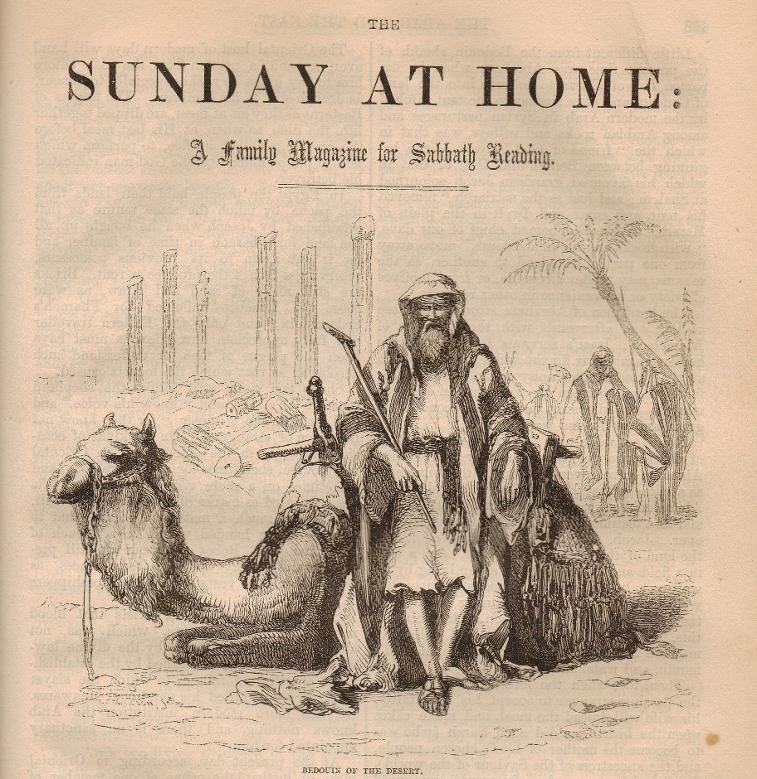
'Bedouin of the Desert' from 'The Arab and the East', Sunday at Home 1861
This must be one of Benwell's earliest depictions of an Arabian Middle-Eastern scene.
He must have been inspired to visit the region not long afterwards. In 1864 he produced one of his earliest known painted (watercolour) Middle-Eastern scenes, 'The Meeting Place'.
"No stronger instance can be adduced of that permanency of Oriental customs to which reference has been made, than the short stick which the Arab we have engraved carries in his hand, for in the hands of the figures sculptured on the most on the most ancient Egyptian monuments, this stick is held. This stick, which has thus been perpetrated for for nearly four thousand years, upon granite, and basalt, and marble, is identical in form and proportions with that carried by almost every Arab in our days from the Euphrates to the NIle. The sandals, too, have as high an antiquity, and there is every probability that when Joseph guided his wife and the infant Saviour of the world across the shorter desert separating Egypt from the land over which Herod tyrannized, that he met with many a group like that in our engraving, and may himself have carried such a stick, and worn such sandals."

'Krishna Chunder's boat boarded by River Pirates' Sunday at Home 1862
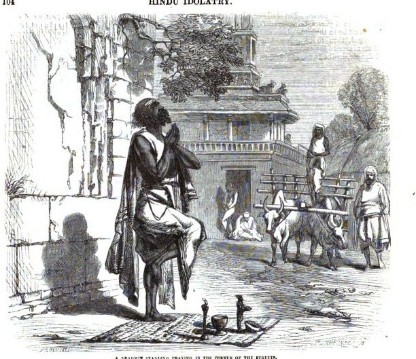
'A Brahmin standing praying in the corner of the streets' Sunday at Home 1863
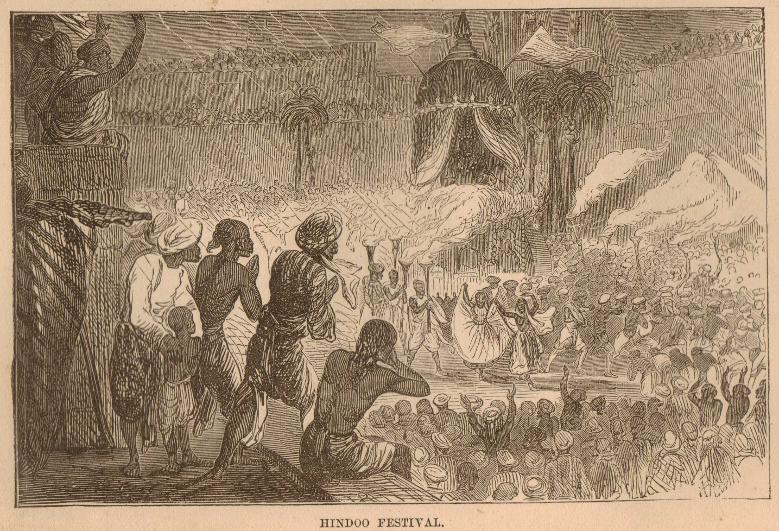
'Hindoo Festival' from 'Grace Ogilvie, the Story of a Child's life in India during the Mutiny' published by the Religious Tract Society 1872.
My copy of this little book is inscribed 'Ernest Salter Wills, Nov 1877, given by him to Violet E Wills' (the Bristol Wills tobacco family). He later became Sir Ernest Salter Wills, and she was Dame Violet Wills, founder of charitable trusts. A larger version of this illustration appears in the Sunday at Home, 1857.
'A Talk by the Watch-Fire' from 'Fountain Kloof: or, Missionary Life in South Africa' Sunday at Home 1863
'The Alphabet Class' from 'Fountain Kloof: or, Missionary Life in South Africa' Sunday at Home 1863
'Could they have been sketched by Bushmen?' from 'Fountain Kloof: or, Missionary Life in South Africa' Sunday at Home 1863
'African Witch-Doctor' from 'Fountain Kloof: or, Missionary Life in South Africa' Sunday at Home 1863
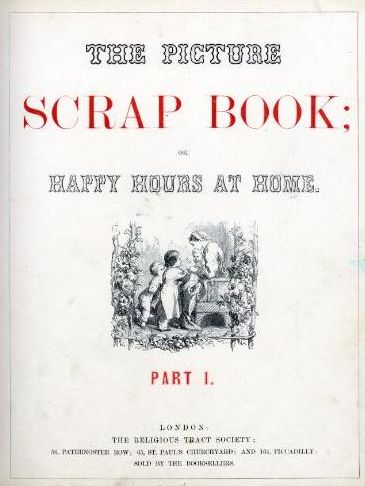
Title page of 'The Picture Scrap Book or Happy Hours at Home' 1859
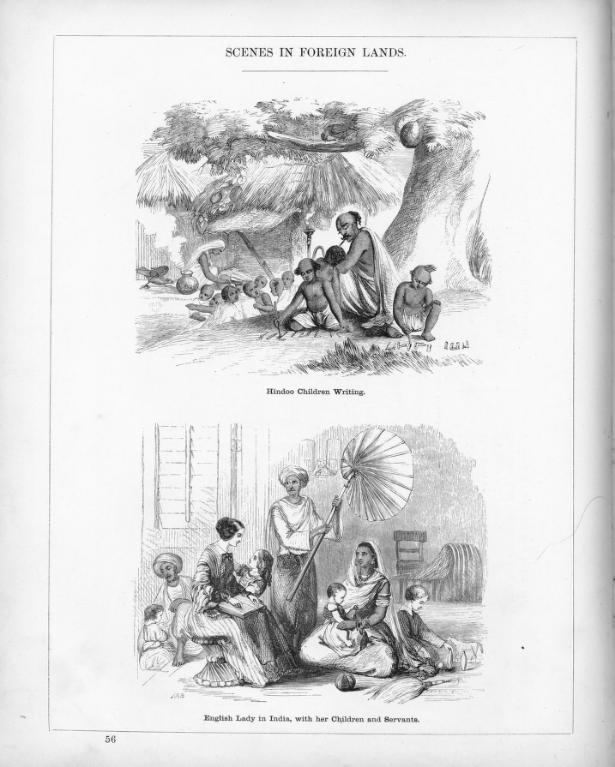
One of the pages in The Picture Scrap Book 1855, 'Hindoo Children Writing;' and 'English Lady in India with her Children and Servants'
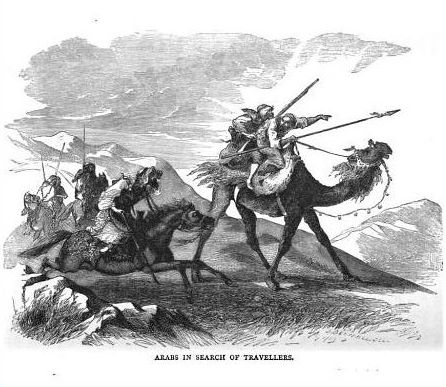
'Arabs in Search of Travellers' from 'A Home in the Land of Snows and other Sketches of Missionary Life' 1870 by Miss Brightwell
'Expulsion of French Protestants from Brazil' from from 'A Home in the land of Snows and other Sketches of Missionary Life' 1870 by Miss Brightwell
A Marvellous Escape' from 'A Home in the land of Snows and other Sketches of Missionary Life' 1870 by Miss Brightwell
' A Scene on the Ganges' from 'A Home in the land of Snows and other Sketches of Missionary Life' 1870 by Miss Brightwell
'The Judean Shepherd' Sunday at Home 1857
'Massacre of the Crew by the Africans' Sunday at Home 1859
'Brahmin warning off a Pariah from the Sacred Circle within which he is eating' Sunday at Home 1864
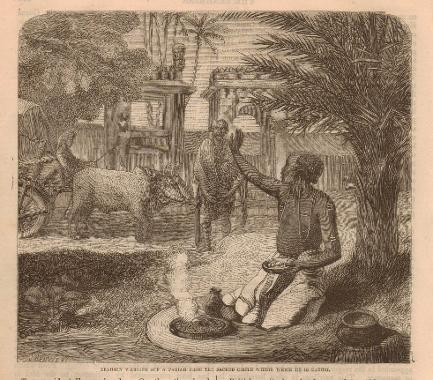
Hindoo Funeral' Sunday at Home 1865
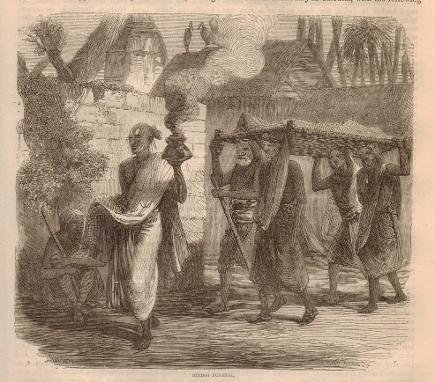
'Say your Prayers in Fair Weather' Sunday at Home 1870
‘Swartz summoned to the presence of the Nabob of the Carnatic’,
Life of Swartz (Part 1), Sunday at Home 1860
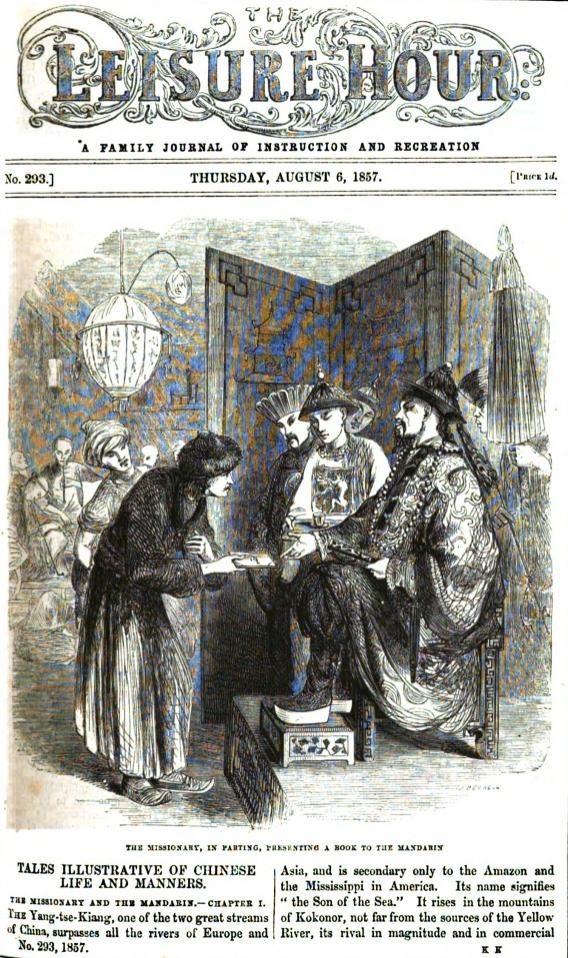
'The Missionary, in parting, presenting a a book to the Mandarin' from 'Tales Illustrative of Chinese Life and Manners', The Leisure Hour 1857
'The Missionaries in the Hall of Audience' Sunday at Home 1862 (from 'The Gospel in Burmah'). American missionaries Dr Adoniram Judson and Mr Colman, 1820.
"When Dr Judson was labouring at Rangoon, vexatious opposition was offered by the local authorities. In hope of obtaining the protection of the king, he boldly resolved to proceed to Ava and to seek an audience". ...."He came forward unattended, -in solitary grandeur,- exhibiting the proud gait and majesty of an eastern monarch. His dress was rich but not distinctive; and he carried in his hand the gold-sheathed sword, which seems to have taken the place of the sceptre of ancient times." ....."When he drew near we caught his attention. He stopped, partly turned toward us: 'Who are these? 'The teachers, great king,' I replied. 'What, you speak Burman- the priest that I heard of last night? When did you arrive? Are you teachers of religion? Are you like the Portuguese priest? Are you married? Why do you dress so?" ......"Moung Zah now began to read the petition...." .........."He held the tract long enough to read the first two sentences, which assert that there is one eternal God, who is independent of the incidents of mortality, and that beside him there is no God; and then, with an air of indifference, perhaps disdain, he dashed it down to the ground. ..........'Why do you ask for such permission? have not the Portuguese, the English, the Mussulmans, and people of all other religions, full liberty to practise and worship according to their own customs? ....."
This illustration also appears as 'Judson before the Burmese Emperor' in 'The Vanguard of the Christian Army' [or, 'Sketches of Missionary Life'] published by the Religious Tract Society, 1882.
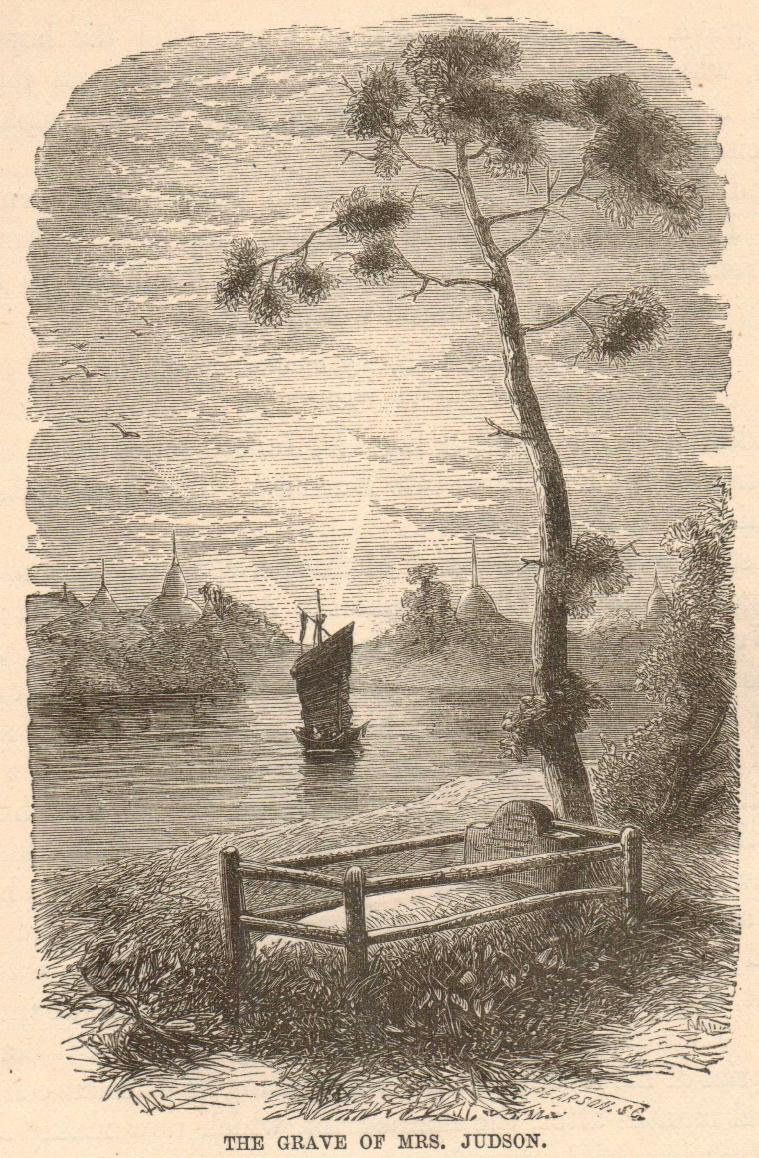
'The Grave of Mrs Judson' from 'The Vanguard of the Christian Army' [or, 'Sketches of Missionary Life'] published by the Religious Tract Society, 1882.
(Artist JAB, engraver Pearson)
'The Grave of Mrs Judson' from 'The Vanguard of the Christian Army' [or, 'Sketches of Missionary Life'] published by the Religious Tract Society, 1882. (Artist JAB, engraver Pearson)
Ann Judson died on 24 October 1826 at Amherst (now Kyaikkami). Her husband was away acting as interpreter to the British envoy, who was negotiating a treaty with the emperor. "The doctor is decidedly of opinion that the fatal termination of the fever is not to be ascribed to the localities of the new settlement, but chiefly to the weakness of her constitution, occasioned by the severe privations and long-protracted sufferings she endured at Ava. "On the 26th of April, just six months after the death of Mrs Judson, little Maria was laid at rest beside her mother".
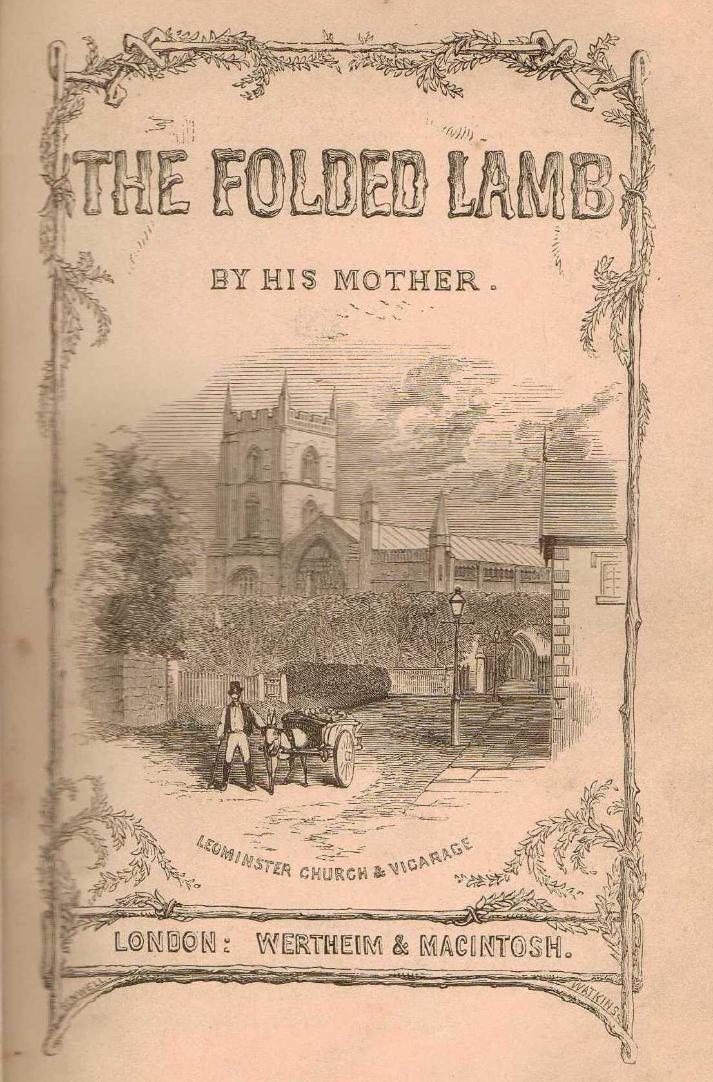
Title page from the 1857 edition of 'The Folded Lamb; Memorials of an Infant Son' by Mrs Ellen M Rogers (Mrs G A Rogers), published by Wertheim & Macintosh (Benwell -artist/illustrator, Watkins -engraver).
This book is referenced in the National Art Library at the Victoria & Albert Museum. It is noted that this second edition (the first edition was 1851) has an "added wood-engraved title page by Watkins after Benwell, conjunct with frontispiece".
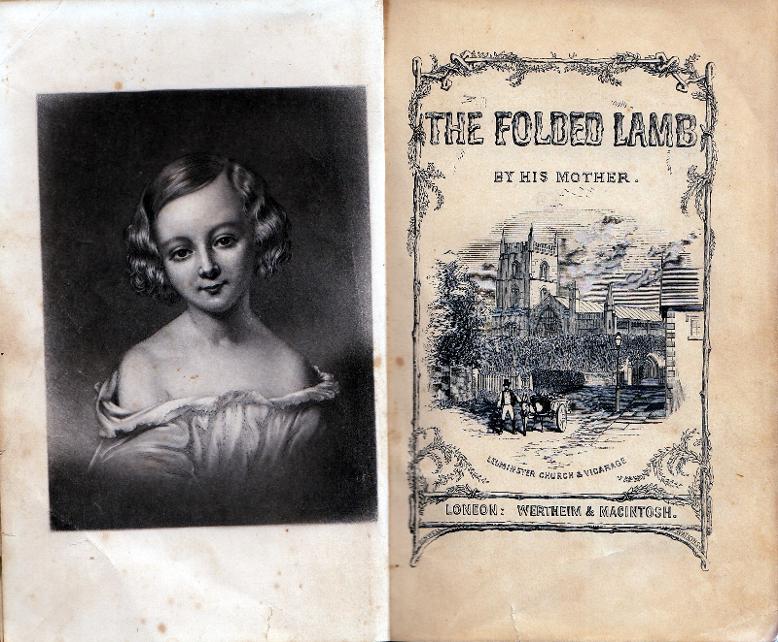

Material researched and written by Dee Murray. Website compiled by Dee Murray.
All images on this website are either scanned or photographed from the author’s own resources, or are in the public domain in digital format via websites such as HathiTrust, Openlibrary.org, the Internet Archive (archive.org) or Google Books.